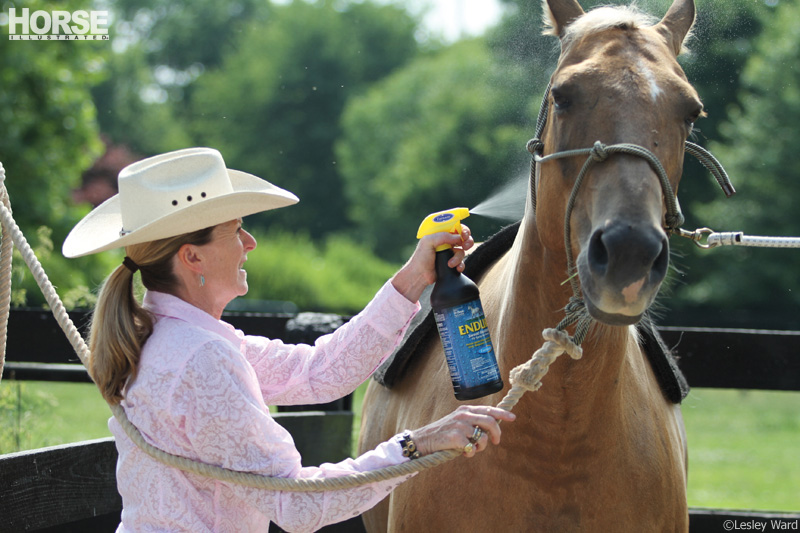
A: If I didn’t know better, I’d swear you were my barn owner secretly asking about her Lipizzan! From personal experience, it can be beyond frustrating to watch these horses suffer and feel like you’re not doing enough to help them.
Not everyone may know what you mean by “sweet itch,” so here’s a description from my well-worn copy of Veterinary Clinics of North America: Equine Practice April 1995 (Vol. 11, No. 1):
Culicoides spp are known as no-see-ums, biting midges, and punkies. The flies are extremely small (1-3mm) and inflict an extremely painful bite. The flies are active during warm weather when there is little or no breeze. Feeding occurs from twilight to dawn. The larvae of Culicoides develop in any body of standing water, decaying vegetation, and manure. Culicoides flies are the intermediate host for Onchocerca cervicalis. Culicoides induce a well-documented hypersensitivity [allergic] reaction in horses that seems to be familial [inherited], and is known by several colloquial names, including Queensland itch, Kasen, sweet itch, muck itch, summer eczema, and dhobie itch.
Since, as you’re aware, there can be a lot of effort and cost associated with protecting your horse from attack by these insects, it’s important to make sure you’re waging war against the right insects. Where in the environment larvae develop, what time of day adults feed, and which control measures are actually effective can vary between insect species such as Culicoides midges, horse flies, deer flies, horn flies, stable flies, black flies, house and face flies, and mosquitoes. So I strongly urge you to work closely with your local veterinarian if you aren’t already. He or she will have direct access to a board-certified veterinary dermatologist (probably at the nearest veterinary school) that can help make sure you’re directing your attention to the correct insect via the very latest diagnostic tools and treatment regimens.
It sounds like you’re already doing a lot of things right, such as using barrier techniques like fly sheets with neck covers. Unfortunately, while fly sprays may provide temporary relief (while riding, for instance), studies have shown them to be generally ineffective in repelling midges. Installing small mesh screens over doors and windows and the use of fans are both much more helpful in keeping these tiny-bodied, weak fliers away from your horse’s body. Also, experts advise keeping your horse stabled during peak midge-feeding times of the day, which usually begins as dusk and ends at dawn but can vary between species.
When the itching becomes unbearable and your horse is doing more damage to himself than the insects, it may be time to ask your veterinarian about prescription medications like corticosteroids, antihistamines, and even antibiotics to control secondary infections. There may be additional answers in the realm of alternative medicine, plus don’t forget about the benefits of feeding for health. A 2002 study by O’Neill and others concluded that “flaxseed was able to reduce the lesional area of the skin test response of atopic horses, alter the fatty acid profile of the hair, reduce inflammation, and did not elicit any negative side-effects in the experimental horses.” The omega 3 fatty acids found in flaxseed as well as chia seed and fish oil have been reported to provide relief from seasonal skin allergies.
Finally, consider immunotherapy. My barn owner just got back from a visit to our nearby veterinary school where the board-certified dermatologist evaluated her horse and performed a complete diagnostic work-up, including an intradermal skin test (IDST) and serum IgE (blood antibody) testing. The end result was that they identified a few allergens for him and, for those that can’t be completely eliminated like sheepskin can, she was custom-made an allergenic extract to place under his tongue, called Sublingual Immunotherapy or SLIT. Considered by some to be superior to Subcutaneous Immunotherapy (SCIT) or “allergy shots,” two pumps are squirted in the oral cavity twice a day. It may take months or years before “Teddy” improves, but at least she has an accurate diagnosis, treatment plan, and is sure her environmental measures are sound. I hope you are able to eventually get to the same, safe harbor!







cool
Sweet itch sounds very bad, thank you for the article.
great info
Yikes
Reference was made to flaxseed, chia seed and fish oil. I would like to know the amount to each to give a 1200# horse.Thank you!